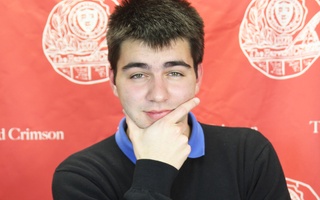{shortcode-c785ce31d0f205c042f9cfa3327bef2b0b417020}
“It’s more exciting than lighting a Christmas tree,” said Jen Mergel, senior curator of contemporary art at the Museum of Fine Arts, last Friday at Boston’s Marketplace Center. After she and Boston mayor Marty Walsh delivered the opening remarks to what felt like a momentous occasion, onlookers finally got what they had been waiting half an hour for—the inflation of a giant fabric fruit tree.
South Korean artist Choi Jeong Hwa, who constructed this unnatural wonder, believes that the artificial fruits found in Seoul street markets are just as beautiful as art found in a museum. Perhaps this is why he chose to make “Fruit Tree,” an artificial cornucopia bountiful with fake fruit of disportionate sizes, like watermelons, strawberries, and peaches. The tree is definitely “top-heavy”—ties had to be secured to its giant head of fruit to ensure the wind would not topple this piece of contemporary art one way or another. But maybe that's also why so many onlookers flocked to see its inflation. Maybe it’s the juxtaposition of its precarious nature and the immortality of its artificial fruit that made the audience wait and watch.
{shortcode-335d18215abb7b212789bede766af8610bda3910}
Or maybe it’s the questions “Fruit Tree” invites: What does fruit reveal about us? What does a rotting apple suggest about the fleeting nature of human life? What do pieces that take that frailty and turn it on its head, making it immortal through fabric and wire and air, suggest about our darkest aspirations and innate fears? What type of fruit—fabric or flesh—truly represents an individual?
When asked what fruit he would be if he were one, Mayor Walsh turned his head to look at “Fruit Tree,” squinting in the blinding sunlight. “That’s a good question. Maybe an apple or banana,” he said. “I don’t know why.”
While Mayor Walsh’s answer may be uncertain, the promise of a free ticket to the museum isn’t. Those who take photos with “Fruit Tree” will receive free admission as a part of the MFA’s “Megacities Asia” exhibit. Maybe that’s the real reason so many crowded around “Fruit Tree,” marvelling at and documenting the 23-foot tall behemoth’s presence in numerous selfies.
{shortcode-1c61a66681ed386ffecf7b8647d80685db9e1166}
—Staff writer Grace Z. Li can be reached at grace.li@thecrimson.com.
Read more in Arts
Freshmen Take the Stage in ‘All’s Fair!’Recommended Articles
-
FORBIDDEN FRUITLife seems to be full of little irritations that pursue a man wherever he goes. Whether it be that darned
-
Appleton Chapel.Despite the rainy night, Appleton Chapel was filled last evening with those who went to hear the Rev. Phillips Brooks.
-
Gene Implicated in Fighting StylesIn the battle of the sexes, one gene may explain differences in male and female fighting styles, a Harvard Medical
-
The Other JohnJohn the Orange Man began selling fruit in Harvard Square in 1858, about a decade after he immigrated to Cambridge to escape the Irish potato famine. He worked in the Square until his death following an operation in 1906, and during that period, saw the erection of 26 university buildings, and made the acquaintance of Henry Wadsworth Longfellow, Oliver Wendell Holmes, and Theodore Roosevelt. In 1891, the Boston Daily Globe dubbed him “the most popular man at Harvard.”
-
 Arts Vanity Issue: Infinite Zest- A Review of My Breakfast
Arts Vanity Issue: Infinite Zest- A Review of My Breakfast













